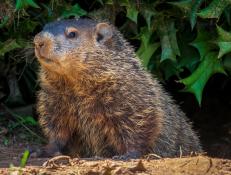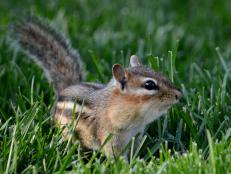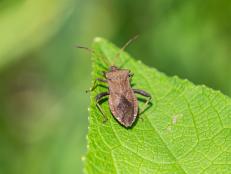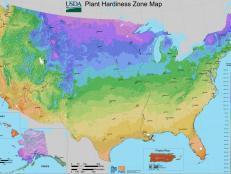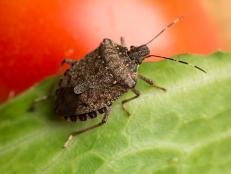Cicadas 2024: Everything You Need to Know
Two types of cicadas will emerge this year. This is a rare natural phenomenon that hasn’t happened since 1803! Learn about these fascinating creatures and find a few practical considerations for your home and garden.

Cicadas haven’t needed a PR department because they don’t do any of the typical icky insect pastimes like biting, stinging, darting or creeping. They don’t eat our precious plants. And they’ve provided the soundtrack of summer for many of us. So, public sentiment is remarkably positive as far as insects go.
This year is significant for the sheer number of periodical cicadas expected across the eastern half of the US — possibly a trillion cicadas in all.
In This Article
- Why Are Cicadas Emerging in 2024?
- Where Will the Cicadas Emerge?
- What to Expect During the Cicadas Emergence
- When Will the Periodical Cicadas Emerge?
- Why do Cicadas Make So Much Noise?
- How Long Will the Cicadas Be Around?
- Will the Cicadas Harm My Trees and Plants?
- Which Plants Should I Be Concerned About?
- How Can I Protect Delicate Trees From Periodical Cicadas?
- Will Eating Cicadas Harm My Pet?
- What Should I Pay Attention to Around the House?
- The Benefits of Cicadas

Gene Kritsky
There are seven species of periodical cicada, all in the genus Magicicada. We will have the opportunity to meet all seven species in 2024, thanks to a co-emergence of Brood XIII and Brood XIX.
Why Are Cicadas Emerging in 2024?
Synchronized Vs. Unsynchronized
Cicadas are intriguing because most of their lives are spent literally under our radar, as nymphs underground. We’re only aware of them when they emerge for a month or so to mate and lay eggs, then poof — they're gone. Every state in the continental US has annual cicadas that we see every year because they have life cycles of two to five years that are unsynchronized, meaning some are up while others are down.
Periodical cicadas are special because they have a synchronized 13-year or 17-year life cycle, depending on the species. So, when they emerge (climb out of the soil) after more than a decade and all at the same time (that's the synchronized part), it’s really something. Scientists are not entirely sure why they do this, but they think part of it is predator avoidance: With that many cicadas all at once, some are able to survive and reproduce even if a bunch gets eaten before the opportunity.
What is a Brood?
The term brood refers to a regional grouping of periodical cicadas that share the same schedule. This year is a big deal in the cicada-sphere because two broods will emerge. That could be a trillion cicadas in total, but over a couple of months across a large swath of the eastern half of the US.

Gene Kritsky
Periodical cicadas spend the vast majority of their 13-year or 17-year lives as nymphs underground, then emerge in large numbers at the same time as part of a synchronized life cycle.
Where Will the Cicadas Emerge?
There are seven species in the periodical cicada genus Magicicada, and we have the opportunity to meet each of them, which is another unusual thing about 2024.
Brood XIX (19), also called the Great Southern Brood, has four Magicicada species on a 13-year cycle. The Brood XIX territory is massive, including much of the South and then some. States expected to experience Brood XIX are Alabama, Arkansas, Georgia, Iowa, Illinois, Indiana, Kentucky, Louisiana, Maryland, Missouri, Mississippi, North Carolina, Oklahoma, South Carolina, Tennessee and Virginia, according to enthusiast website Cicada Mania.
Brood XIII (13), the Northern Illinois Brood, has three Magicicada species on a 17-year cycle. Brood XIII has a smaller territory in the northern Midwest, that includes — you guessed it — Illinois, but also Indiana, Iowa and Wisconsin.
The last time these broods emerged in the same year was in 1803. If you were hoping to see both, they have a very small overlapping territory in Illinois, according to the University of Connecticut.

Gene Kritsky
Beginning in April, the US will experience a double emergence of periodical cicadas. The map shows where the 17-year Brood XIII (shown in blue) and the 13-year Brood XIX (shown in red) occur.
What to Expect During the Cicadas Emergence
Some cities could see a million periodical cicadas an acre and others nothing. It all depends on where your locals went into the soil 13 or 17 years ago and how life has gone for the nymphs since then. Entomologist Gene Kritsky of Mount St. Joseph University developed Cicada Safari, a mapping app that allows users to find verified local sightings and report their sightings. The areas of the country where the two 2024 broods occur are shown on the map above.
Kritsky is also the author of A Tale of Two Broods, a book about the 2024 double emergence, and he was kind enough to answer some of our practical questions, like, if there’s a way to know in advance if there are periodical cicada nymphs in your yard. He says we could be in luck if there’s heavy rain because nymphs will sometimes make mud chimneys. “This is often two weeks before the emergence starts,” Kritsky says.
When Will the Periodical Cicadas Emerge?
Periodical cicadas start emerging when it’s warm — a comfy 64-degree ground temperature, to be specific — so that happens as early as April in Southern states, later as you move northward. Periodical cicadas have an earlier schedule than most annual cicadas.
Why do Cicadas Make So Much Noise?
The cacophony we associate with adult cicadas is referred to as a chorus. It is primarily produced by the males and it is ALL about reproduction. Male cicadas have a pair of abdominal membranes called tymbals they use to sing and a hollow abdomen amplifies their songs. The female cicadas answer with a subtle (by comparison) clicking sound, produced by flicking their wings. Each cicada species has a different sound.
How Long Will the Cicadas Be Around?
If they can avoid being eaten, adult periodical cicadas will live for about a month. The eggs the females lay will hatch after 6 to 7 weeks, at which point the nymphs drop out of the tree and burrow underground. This part is much quieter.

Gene Kritsky
There are seven species of periodical cicada, all in the genus Magicicada. All periodical cicadas are black with orange wing veins.
How Will I Recognize the Periodical Cicadas?
In the Midwest, where Kritsky hails from, annual cicadas usually emerge at the beginning of July, which is after periodical cicadas have died off. “However, in 2019, the first annual cicadas overlapped with the few remaining Brood VIII periodical cicadas,” he says.
Visually they’re often easy to distinguish, according to Kritsky. All the periodical cicadas are black and many of our annual cicadas are green. If the cicada you see is green, it isn’t a periodical. If your area has annual cicadas that are also black, Kritsky gives us a few more ways to tell. “The various species of dog-day, or annual, cicadas are larger than their periodical cousins and have black or greenish eyes,” he explains. “Their heads are wide and flattened, not slightly rounded as in the periodical cicadas.”
Will the Cicadas Harm My Trees and Plants?
No. Cicadas will suck on your trees and woody plants through a proboscis — both as adults and as nymphs underground — but cicadas don’t harm plants by feeding. In fact, cicadas do not have mouth parts to chew, so if something’s munching on your tomatoes, don’t blame the cicadas.
But periodical cicada nesting activities — especially during large emergences — can be intense. There are just so many of them! Kritsky explains the nesting process in his book. After mating, the female cicada creates a little slice in a tree twig in which to deposit 10 to 20 eggs. She moves up the branch and repeats the process until she’s laid all her eggs, around 500 in number. The female cicada prefers new growth near the end of the branch for her nests. This can sometimes result in local damage called flagging, in which the twig breaks and the leaves die. This flagging can be unsightly, but it often isn’t a problem.

Gene Kritsky
The creation of eggnests in small-diameter branches by female cicadas can cause flagging, in which the twigs break and the leaves die. This natural pruning won’t harm mature trees and is thought to result in greater blossom and fruit production in the year following an emergence.
Which Plants Should I Be Concerned About?
Because cicadas desire woody growth, they aren’t interested in your flowers or vegetables. Mature trees and shrubs are hardy enough to withstand flagging, so it’s not an issue for established vegetation either. The greenery that can be vulnerable to cicada damage is young or small woody plants and trees that have many of the small-diameter limbs that female cicadas prefer. This includes fruit trees.
It should be some comfort that your interest and the female cicada’s align here. If a twig flags, up to 50% of the eggs laid in it won’t hatch. Further, since the cicada nymphs live on the fluid from the roots of the tree they hatched from, the female cicada needs a tree with a lifespan of at least 13 or 17 years. For these reasons, female cicadas are very selective in their choice of tree, Kritsky writes. Their favorites? Trees in full sunlight with low vegetation surrounding them.
How Can I Protect Delicate Trees From Periodical Cicadas?
A shift in the planting schedule may be all that’s needed, says Kritsky. Just wait to plant until after the adult periodical cicadas have died off. For existing garden residents, small-diameter mesh netting works. “If there are small young trees in the yard, you can cover them with netting to stop females from laying eggs,” Kritsky advises. He says to focus on the small stuff, adding that cicadas will lay eggs in woody shrubs, too, especially if the emergence is large and there is competition for suitable branches.
Should I Prune Flagged Branches?
Kritsky recommends letting nature take its course and skipping the pruning because in most cases the tree will recover. In fact, nature taking its course may really benefit those trees. Kritsky’s book cites reports of increased flower and fruit production during the year after a periodical cicada emergence as a result of nesting activities.
Should I Use Pesticides to Control Periodical Cicadas?
No! Kritsky does not recommend the use of pesticides, as they are not an effective means of controlling cicada numbers. He says netting works better.
What About Plant Diseases or Parasites Using Nest Sites?
If you must prune, Kritsky says to wait a couple of months after your local emergence to ensure the cicada nymphs have hatched. “As a rule of thumb, the eggs will have hatched by the first of September,” he explains.
Will Eating Cicadas Harm My Pet?
Just reading that question, some pet owners are having vivid recollections of the unmistakable crunch. Luckily, eating a few cicadas won’t harm most pets. According to the ASPCA, the primary concern is the chitin in cicadas’ exoskeletons. It is difficult to digest, so if your dog or cat eats too many cicadas, it can result in a GI blockage. Also (rarely), some pets are allergic to chitin.
Cicada snacks are another good reason not to use pesticides in your yard. When cicadas are exposed to pesticides, they expose all the animals who consume them to those harmful chemicals as well. This includes owls, bats, lizards, squirrels, raccoons, your favorite birdfeeder birds… and your dog or cat.
What Should I Pay Attention to Around the House?
Aside from sweeping paths and cleaning garden beds regularly, there are a few spaces to monitor around the home to prevent costly maintenance.
- Cicada carcasses can fill up gutters during a time of year when we may not be used to having to clean them, so this year add it to the schedule.
- Shell casings will easily clog pool skimmers and filters, so check them often.
- Throw a net over that koi pond or you could end up with oxygen depletion from decomposing carcasses in the water.
- HVAC servicers report periodical cicadas gathering on outdoor air conditioning components and causing strain on the unit due to decreased airflow. The solution: Once a week, spray them off the compressor using a garden hose.
The Benefits of Cicadas
You mean aside from the fabulous concert? Actually, a ton! Kritsky says the tunnels the nymphs emerge from aerate the soil. Nesting activity acts as natural pruning to stimulate flower and fruit production. The carcasses make a nitrogen-rich contribution to our yards and compost piles.
Cicadas are a protein-rich meal for the insects’ natural predators — what seems like every animal in the vicinity. Kritsky calls the large numbers of periodical cicadas in an emergence a food bonanza that benefits those animal populations. In many parts of the world, cicadas are on the menu. Find out more on safe consumption and get recipe ideas on our sister site, Food Network. Spoiler alert: Cicadas are not for those with shellfish allergies.
Where Can I Learn More?
- Dr. Kritsky wants the public’s help mapping the 2024 double emergence. Visit Cicada Safari and download the app to find local sightings and post your own.
- The University of Connecticut has an informative page devoted to this year’s emergence.
- The enthusiast site, Cicada Mania, is all things cicada all the time and has photos of cicada mud chimneys and emergence tunnels.







